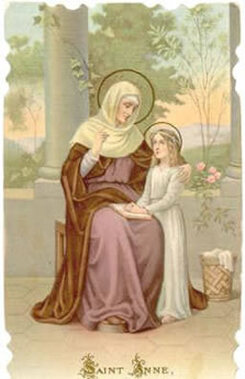Our Patron - St Anne (Feast Day 26th July)
|
Saints are significant today because –
St Anne – A Special Saint
|
Profile
Canonized: 1584
Name Meaning: Gracious one; grace
- Mother of Our Lady
- Grandmother of Jesus Christ
- Wife of Saint Joachim
- Probably well off
- Believed to have given Mary to the service of the Temple when the girl was three years old
Canonized: 1584
Name Meaning: Gracious one; grace
Prayer to St Anne
"Good Saint Anne, you were especially favoured by God to be the mother of the most holy Virgin Mary, the Mother of our Saviour. By your power with your most pure daughter and with her divine Son, kindly obtain for us the grace and the favour we now seek. Please secure for us also forgiveness of our past sins, the strength to perform faithfully our daily duties and the help we need to persevere in the love of Jesus and Mary. Amen."
"Good Saint Anne, you were especially favoured by God to be the mother of the most holy Virgin Mary, the Mother of our Saviour. By your power with your most pure daughter and with her divine Son, kindly obtain for us the grace and the favour we now seek. Please secure for us also forgiveness of our past sins, the strength to perform faithfully our daily duties and the help we need to persevere in the love of Jesus and Mary. Amen."
St Anne – A Brief Biography
Of St. Anne we have no certain knowledge. She is not mentioned in the New Testament, and we must depend on apocryphal literature, chiefly the Protoevangelium of James, which dates back only to the second century.
In this document we are told that Anne, wife of Joachim, was advanced in years and that her prayers for a child had not been answered. Once as she prayed beneath a laurel tree near her home in Galilee, an angel appeared and said to her, "Anne, the Lord hath heard thy prayer and thou shalt conceive and bring forth, and thy seed shall be spoken of in all the world." Anne replied, "As the Lord my God liveth, if I beget either male or female, I will bring it as a gift to the Lord my God; and it shall minister to Him in holy things all the days of its life." And thus Anne became the mother of the Blessed Virgin Mary.
The devotion of St Anne was known in the East in the fifth century, but it was not diffused in the West until the thirteenth. A shrine at Douai, in northern France, was one of the early centres of the devotion. In 1382 her feast was extended to the whole Western Church, and she became very popular, especially in France. Her two most famous shrines are at St. Anne d'Auray in Brittany and at St. Anne-de Beaupre in the province of Quebec.
She is patroness of housewives, women in labor, cabinet-makers, and miners. Her emblem is a door. St. Anne has been frequently represented in art, and the lovely face depicted by Leonardo da Vinci comes first to mind in this connection. The name Anne derives from the Hebrew Hannah, meaning "grace."
Of St. Anne we have no certain knowledge. She is not mentioned in the New Testament, and we must depend on apocryphal literature, chiefly the Protoevangelium of James, which dates back only to the second century.
In this document we are told that Anne, wife of Joachim, was advanced in years and that her prayers for a child had not been answered. Once as she prayed beneath a laurel tree near her home in Galilee, an angel appeared and said to her, "Anne, the Lord hath heard thy prayer and thou shalt conceive and bring forth, and thy seed shall be spoken of in all the world." Anne replied, "As the Lord my God liveth, if I beget either male or female, I will bring it as a gift to the Lord my God; and it shall minister to Him in holy things all the days of its life." And thus Anne became the mother of the Blessed Virgin Mary.
The devotion of St Anne was known in the East in the fifth century, but it was not diffused in the West until the thirteenth. A shrine at Douai, in northern France, was one of the early centres of the devotion. In 1382 her feast was extended to the whole Western Church, and she became very popular, especially in France. Her two most famous shrines are at St. Anne d'Auray in Brittany and at St. Anne-de Beaupre in the province of Quebec.
She is patroness of housewives, women in labor, cabinet-makers, and miners. Her emblem is a door. St. Anne has been frequently represented in art, and the lovely face depicted by Leonardo da Vinci comes first to mind in this connection. The name Anne derives from the Hebrew Hannah, meaning "grace."




